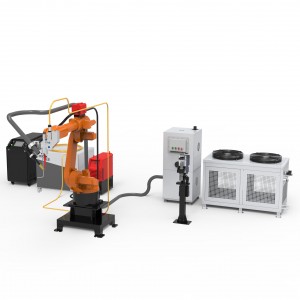The shipbuilding industry is an important pillar industry of the country. In this industry, joint welding is an important project, among which T-type joints account for nearly 70%. The traditional T-type joints usually adopt arc welding, but this method has some problems that cannot be ignored, such as inaccurate formation, low welding efficiency, large heat-affected area, and relatively shallow welds. The laser-electric arc composite welding technology, due to its high energy density, has attracted much attention. It has advantages such as low heat input, high welding speed, large-depth-to-width ratio welds, narrow heat-affected zone, and small welding deformation. Using the laser-electric arc composite welding technology for T-type joint welding can achieve efficient, aesthetically pleasing results, with smaller welding deformation, and superior mechanical properties of the welded joints. At the same time, the mechanical properties of the welded joints are also more superior.
Welding process:
Workpiece cleaning: Since oxide films and stains may enter the weld during the welding process, to prevent interference with the welding effect, the surface oxide films of the welds are ground with an angle grinder before the assembly, and the workpieces are cleaned and dried with anhydrous ethanol to remove the oil stains on the workpiece surface.
Clamping the workpiece: Using specially designed fixtures, the two workpieces are assembled at a 90° angle to form an experimental workpiece. The two test plates are respectively called the flat plate and the upright plate.
Groove form: If the T-type joint does not have a groove, the weld will not have undercut defects, and it also reduces processing costs and improves production efficiency; if a groove is opened, the weld with the groove will have undercut due to the additional space for filling.
Laser beam and panel inclination angle: The angle of the laser beam to the panel has an impact on the weld penetration. The appropriate inclination angle will make the weld penetration larger, so the panel and web of the web can be well fused together at the weld root.
Process parameters: Laser power: 9kW; wire feeding speed: 10m/min; welding speed: 70cm/min; in addition, the side-blowing gas and gas flow also have an impact on the welding process.
The influence of laser-electric arc composite welding technology on T-type joints:
(1) Welding quality: The laser-electric arc composite welding technology can provide high energy density, making the welding process more in-depth and concentrated. This helps achieve deep penetration of the weld, thereby improving the quality and strength of the weld. For T-type joints, the quality of the weld directly affects the strength and stability of the overall structure.
(2) High efficiency and accuracy: The laser-electric arc composite welding technology has the characteristics of high efficiency and precise control. In the welding of T-type joints, the high efficiency of the welding speed and precise welding control can ensure the consistency of the welding quality, while improving production efficiency.
(3) Reduction of heat-affected zone: The high energy density of laser welding helps reduce the heat-affected zone, that is, the area heated during the welding process. Reducing the heat-affected zone can reduce the thermal deformation of the material, thereby improving the geometric accuracy of the joint.
(4) Welding shape control: This welding technology can more precisely control the shape of the weld, which means that the connection parts of the crossbeam and the longitudinal beam can be better controlled, ensuring that the shape of the weld meets the design requirements.
In summary, the laser-electric arc composite welding technology has advantages in the manufacturing of T-type joints, can improve welding quality, processing efficiency, and reduce the heat-affected zone, and is widely used in engineering manufacturing.
Post time: May-30-2025

















